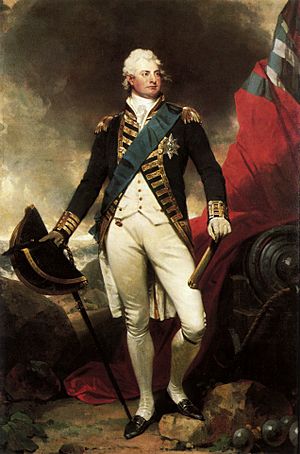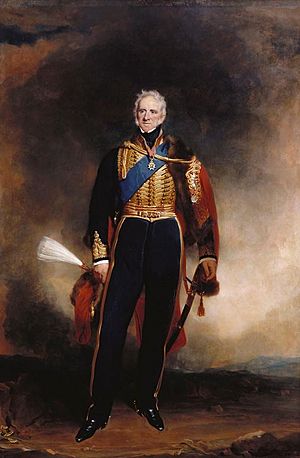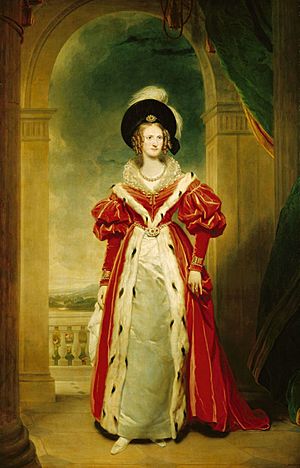Martin Archer Shee facts for kids
Quick facts for kids
Martin Archer Shee
PRA FRS
|
|
|---|---|

Self-portrait (1794)
|
|
| President of the Royal Academy | |
| In office January 1830 – 13 August 1850 |
|
| Preceded by | Sir Thomas Lawrence |
| Succeeded by | Sir Charles Lock Eastlake |
| Personal details | |
| Born | 23 December 1769 Dublin, Ireland |
| Died | 13 August 1850 (aged 80) Brighton, Sussex, England |
| Known for | Portraiture |
Sir Martin Archer Shee (born December 23, 1769 – died August 13, 1850) was a famous Irish artist. He was best known for painting portraits of people. He also held an important job as the President of the Royal Academy, which is a famous art institution in London.
Contents
Early Life and Art Training
Martin Archer Shee was born in Dublin, Ireland. His family was old and respected, and his father was a merchant. His father didn't think painting was a good job for someone from their family. But Martin loved art and decided to study it anyway.
He first went to the Royal Dublin Society to learn about art. In 1788, he moved to London. There, a famous politician named Edmund Burke introduced him to Joshua Reynolds, who was a very important painter. Reynolds told Martin to study at the schools of the Royal Academy of Arts.
Becoming a Famous Artist
In 1789, Martin Archer Shee showed his first two paintings. One was called "Head of an Old Man" and the other was "Portrait of a Gentleman." Over the next ten years, he became more and more successful.
In 1798, he was chosen as an associate of the Royal Academy. This meant he was becoming a recognized artist. In 1789, he married Mary Power. Then, in 1800, he was elected a full Royal Academician. This was a big honor! He moved into a house that another famous painter, George Romney, used to live in. Martin Archer Shee painted many portraits. He also created other kinds of art, like historical scenes. Some of his famous works include "Lavinia" and "Prospero and Miranda."
Writing and Poetry





Besides painting, Martin Archer Shee also enjoyed writing. In 1805, he published a poem called Rhymes on Art. A second part came out in 1809. Even the famous poet Lord Byron said good things about it!
He also wrote another book of poems in 1814. It was called The Commemoration of Sir Joshua Reynolds, and other Poems. He even wrote a play called Alasco, which was set in Poland. The play was accepted by a theater, but it wasn't allowed to be performed. People thought it had ideas that were against the government. Martin Archer Shee was very upset and decided to publish the play as a book instead.
He also wrote two novels, which are longer stories. They were called Oldcourt (published in 1829) and Cecil Hyde (published in 1834).
Leading the Royal Academy
When the previous president, Sir Thomas Lawrence, passed away in 1830, Martin Archer Shee was chosen to be the new president of the Royal Academy. This was a very important position in the art world. Soon after, he was given the title of knighthood, so he became "Sir" Martin Archer Shee. In 1831, he was also elected a Fellow of the Royal Society. This meant he was recognized for his contributions to knowledge and science.
In 1836, he spoke to a group in Parliament about how the Royal Academy worked. He did a great job defending its importance and rights. He continued to paint until 1845, when he became ill. He then retired to Brighton. Another famous painter, J. M. W. Turner, sometimes took his place at the Academy. Martin Archer Shee was also the first president of the Royal Birmingham Society of Artists from 1842 to 1849.
Later Life and Passing
Sir Martin Archer Shee passed away in Brighton in 1850. He was buried in the churchyard of St Nicholas' Church there.
Family Life
Martin Archer Shee had three sons and three daughters. His sons became successful lawyers.
One of his descendants was George Archer-Shee. His true story inspired a famous play called The Winslow Boy, written by Sir Terence Rattigan.
Written Works by Sir Martin Archer Shee
- Elements of art, a poem; in six cantos (1809)
- Rhymes on Art; Or, The Remonstrance of a Painter: in Two Parts (1809)
- The Commemoration of Reynolds: In Two Parts (1814)
- Oldcourt: Volume 1, Volume 2, Volume 3 (London : H. Colburn, 1829)
- Alasco: A Tragedy, in Five Acts (Sherwood, Jones, and co., 1824).

